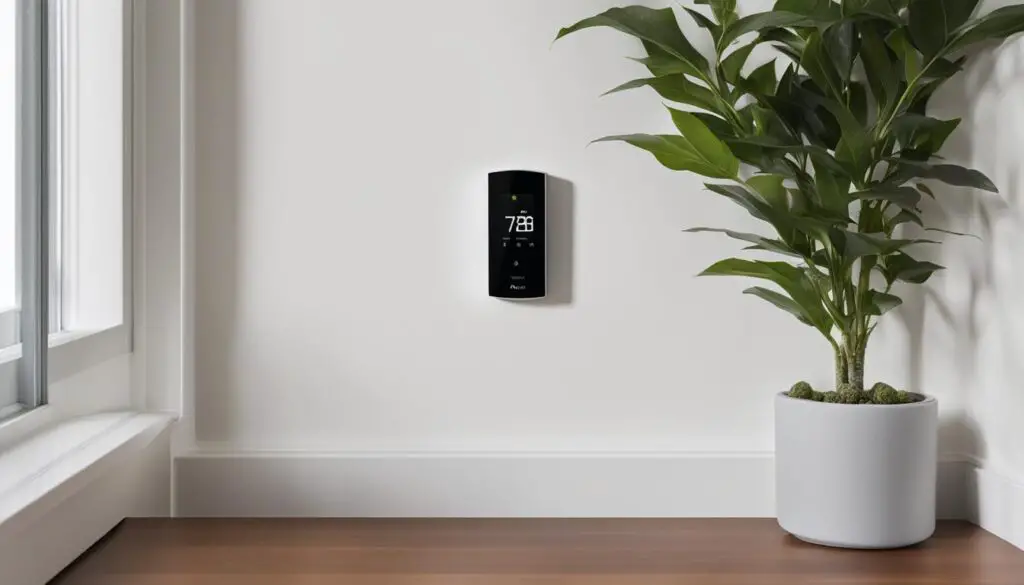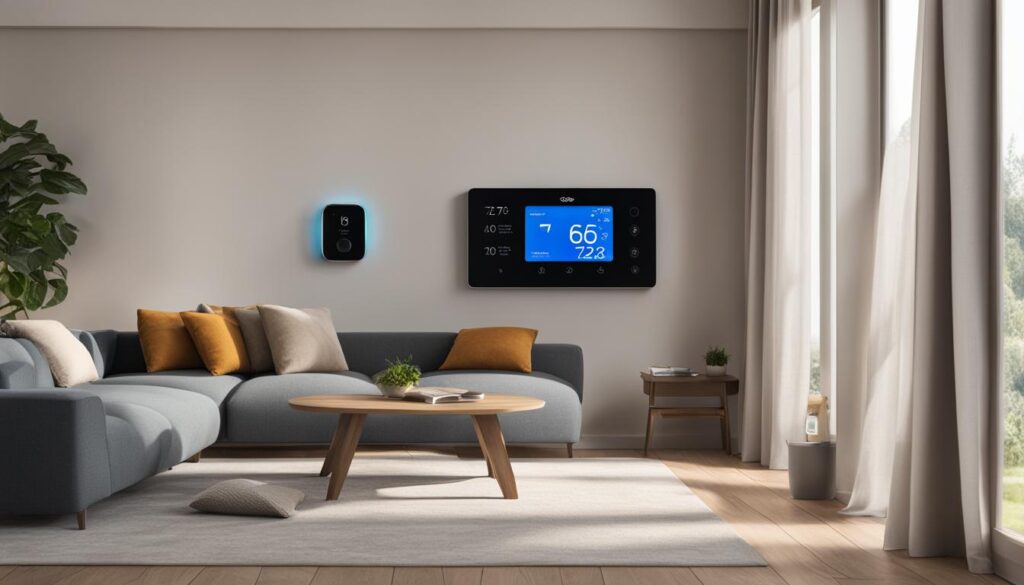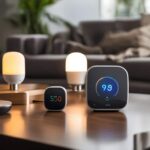Adding smart home devices to your household can have a significant impact on energy saving, allowing you to reduce utility costs and lower your environmental impact. These devices offer advanced features that enable you to control lighting, save on heating and cooling costs, conserve water, and prevent vampire power loss. With the help of smart home hubs like Apple HomePod, Google Home, and Amazon Echo, you have the power to make your home more efficient and eco-friendly.
Table of Contents
Key Takeaways:
- Smart home devices are designed to help reduce utility costs and lower environmental impact.
- They provide control over lighting, allowing you to maximize energy efficiency.
- Smart thermostats, ceiling fans, and window coverings enable you to save on heating and cooling costs.
- Smart sprinklers contribute to water conservation in your lawn or garden.
- Smart plugs help prevent power loss and vampire power consumption.
Control Your Lighting with Smart Light Bulbs and Switches
Smart light bulbs and switches are easy-to-use smart home devices that can help you save energy and reduce electricity costs. These innovative devices provide convenient ways to control your lighting, offering features like remote control and energy efficiency. Whether you want to turn off the lights from your smartphone or automate them based on motion detection, smart light bulbs and switches have got you covered.
Smart light bulbs come in various brands such as Philips Hue, Philips Wiz, Lifx, Cree, Wyze, Ring, and Yeelight. These bulbs offer remote control capabilities, allowing you to turn off lights even when you’re not at home. You can program them to follow a schedule or automatically adjust based on motion detection, ensuring efficient energy usage throughout the day.
On the other hand, smart switches provide a centralized control hub for your lighting. They not only control your lights, but also fans and other appliances. Some switches even come with motion detection capabilities, making them a versatile addition to your smart home setup. If you’re looking for reliable smart switches, brands like Philips, Leviton, Lutron, and iDevices offer a wide range of options.
With smart light bulbs and switches, you can transform your home’s lighting experience while reducing energy costs. Say goodbye to wasted energy from leaving lights on and embrace the convenience of remote control and scheduling. Whether you’re looking to create ambiance with different lighting scenes or simply want to save money on your energy bills, smart light bulbs and switches are the way to go.
Upgrade your lighting system with these smart home solutions and enjoy the benefits of energy efficiency and convenience. In the next section, we’ll explore how you can save on cooling and heating costs with smart thermostats, ceiling fans, and window coverings.
Save on Cooling and Heating with Smart Thermostats, Ceiling Fans, and Window Coverings
When it comes to optimizing energy efficiency in your home, smart thermostats, ceiling fans, and window coverings are essential tools. These smart home devices not only help reduce energy consumption but also provide convenience and comfort through advanced features.
Smart Thermostats for Efficient Temperature Control
Smart thermostats are a game-changer when it comes to regulating heating and cooling in your home. By programming a schedule, you can ensure that your HVAC system operates at optimal levels when you are at home and minimizes energy usage when you’re away.
Leading brands such as Ecobee, Google Nest, Honeywell, and Emerson offer smart thermostats with remote control capabilities. With a smartphone app, you can adjust the temperature settings even when you’re not home. These devices also offer energy consumption insights, allowing you to make informed decisions about your usage.
Having a smart thermostat means greater energy efficiency and savings on your heating and cooling costs. It’s a smart investment that pays off in the long run.
Smart Ceiling Fans for Improved Airflow
Smart ceiling fans are another great addition to your smart home setup. They provide reliable airflow and cooling, reducing the reliance on your HVAC system. Big Ass Fans, Hunter, Hampton Bay, Minka-Aire, and Horevo are trusted brands that offer a wide range of smart ceiling fans.
With remote control and scheduling options, you can optimize the airflow in each room based on occupancy and temperature preferences. Some smart ceiling fans even sync with your smart thermostat to provide efficient temperature regulation throughout your home.
Smart Blinds and Curtains for Light and Temperature Control
Controlling light and temperature is crucial for energy savings and creating a comfortable living environment. Smart blinds and curtains allow you to automate light control and adjust room temperature with ease.
Brands like IKEA, SwitchBot, Graywind, Yoolax, and SOMA offer smart window coverings that can be controlled through smartphone apps or voice assistants. With features like scheduling and remote control, you can optimize natural light and regulate the temperature in your home.
Whether it’s opening your blinds in the morning to let in sunlight or automatically closing them during the hottest part of the day, smart blinds and curtains contribute to energy savings and enhance the overall comfort of your living space.

Is Investing in Smart Thermostats, Ceiling Fans, and Window Coverings Worth It?
Smart thermostats, ceiling fans, and window coverings are not only energy-efficient but also offer numerous benefits for your smart home. The convenience of remote control, scheduling, and energy monitoring provides a holistic approach to energy management.
By reducing energy consumption and optimizing heating and cooling, these devices can lead to significant cost savings on your utility bills. Additionally, the enhanced comfort and control over your home’s environment make investing in smart thermostats, ceiling fans, and window coverings a worthwhile choice.
| Smart Thermostat Brands | Smart Ceiling Fan Brands | Smart Window Covering Brands |
|---|---|---|
| Ecobee | Big Ass Fans | IKEA |
| Google Nest | Hunter | SwitchBot |
| Honeywell | Hampton Bay | Graywind |
| Emerson | Minka-Aire | Yoolax |
Investing in these leading smart home brands ensures reliable performance and compatibility with your existing smart home ecosystem.
In the next section, we explore the benefits of smart plugs in tackling vampire power and saving energy.
Kill Vampire Power with Smart Plugs

Vampire power, also known as standby power, accounts for a significant portion of a household’s energy cost. It refers to the electricity consumed by appliances and devices even when they are not actively in use. This wastage can be easily prevented with the use of smart plugs, which are affordable and convenient energy-saving devices.
Smart plugs have revolutionized the way we power our electronic devices by offering remote control and automation features. With the ability to switch off devices remotely through smartphone apps, you can prevent power loss and eliminate the energy drain caused by devices on standby mode.
Some smart plugs even offer energy monitoring capabilities, allowing you to track and analyze the energy consumption of connected devices. This valuable insight helps you identify energy-hungry devices and make informed decisions to reduce energy usage.
Smart plugs can be used in conjunction with a variety of smart home devices such as smart thermostats, lights, fans, and power strips. By integrating these devices, you can create a comprehensive energy-saving system that maximizes efficiency and convenience.
Here are a few popular options for smart plugs:
| Smart Plug Brand | Description |
|---|---|
| Kasa Smart Plug Mini | Compact and easy to use, this smart plug offers remote control and energy monitoring features. |
| WeMo Wi-Fi Smart Plug | Compatible with voice assistants like Amazon Alexa and Google Assistant, this smart plug provides remote control and scheduling capabilities. |
| iDevices Wall Outlet | This smart plug offers two built-in outlets and can be controlled through smartphone apps or voice commands. |
By incorporating smart plugs into your home’s energy management strategy, you can effectively eliminate vampire power and reduce your energy consumption. Take control of your energy usage and save money in the process.
Motion Sensors for Efficient Lighting Control
Motion sensors are an essential component of any smart lighting system. These devices provide convenient and energy-efficient lighting control by automatically turning lights on or off based on occupancy. By integrating motion sensors into your home, you can ensure that lights are only activated when needed, reducing unnecessary energy consumption.
Motion sensors are versatile and can be used in various areas of your home. Whether it’s the hallway, bathroom, or living room, motion sensors are compatible with all types of smart lights, allowing you to automate your lighting setup seamlessly.
One of the key benefits of motion sensors is their ability to enhance convenience. Imagine walking into a room, and the lights automatically turn on without having to search for a switch. It not only saves time and effort but also creates a seamless and comfortable environment in your home.
Integrating motion sensors with voice assistants like Amazon Alexa and Google Assistant adds another layer of convenience. You can control and manage your lighting system through simple voice commands, making it even easier to create a fully automated and hands-free lighting experience.
Take a look at the table below to explore some popular motion sensor options:
| Brand | Compatible with | Features |
|---|---|---|
| Philips Hue Motion Sensor | Philips Hue Smart Lights | – Wide motion detection range – Adjustable sensitivity – Customizable lighting scenes |
| Wyze Motion Sensor | Wyze Smart Lights | – Compact design – Easy installation – Adjustable motion sensitivity |
| Sonoff PIR2 Motion Sensor | Sonoff Smart Lights | – Wireless connectivity – Long detection range – Battery-powered |
| Abode Motion Sensor | Abode Smart Lights | – Pet-friendly detection – Adjustable motion sensitivity – Battery-powered |
With motion sensors, you can effortlessly automate your lighting system and enjoy the benefits of energy efficiency, convenience, and a truly smart home experience.
Expert Tip:
Consider placing motion sensors in areas where lighting control is crucial, such as frequently used hallways or bathrooms. This ensures that lights are never accidentally left on, leading to energy waste and higher electricity bills.
Smart Sprinklers for Water Conservation
When it comes to maintaining a lush and vibrant lawn or garden, ensuring efficient watering practices is crucial. Smart sprinkler systems offer an innovative solution for water conservation, allowing you to minimize water usage while still achieving optimal plant health.
By incorporating smart sprinklers into your outdoor space, you can take advantage of features such as scheduling and rain delay. These systems enable you to set specific watering times and durations, ensuring that your plants receive the right amount of water without excessive wastage.
One popular option in the market is the Rachio 3 smart sprinkler system. It provides advanced scheduling capabilities, allowing you to create personalized watering plans based on your specific landscape needs. The Rachio 3 also has weather intelligence technology that automatically adjusts watering schedules based on real-time weather conditions, helping you maintain the health of your lawn while minimizing water usage.
Another notable smart sprinkler system is the Orbit B-Hyve XR. This system offers customizable watering schedules and allows you to remotely control and monitor your sprinklers through a smartphone app. It also features a rain delay function that pauses watering during rainy periods, preventing overwatering and conserving water resources.
By investing in smart sprinkler systems like the Rachio 3 or Orbit B-Hyve XR, you can make a significant impact on water conservation efforts while maintaining a beautiful and healthy outdoor environment.
Benefits of Smart Sprinklers for Water Conservation:
- Efficient scheduling to minimize water usage.
- Automatic adjustment based on weather forecasts.
- Remote control and monitoring through smartphone apps.
- Rain delay feature to prevent overwatering.
- Conserves water resources and promotes sustainability.
Investing in smart sprinkler systems not only helps you save water but also reduces your overall environmental footprint. By using technology to optimize watering practices, you can create a greener and more sustainable outdoor space.
Comparison of Smart Sprinkler Systems
| Smart Sprinkler System | Scheduling and Automation | Weather Adaptation | Remote Control |
|---|---|---|---|
| Rachio 3 | Advanced scheduling features | Real-time weather adjustments | Yes |
| Orbit B-Hyve XR | Customizable watering schedules | Rain delay function | Yes |
Smart Home Energy Monitors for Real-Time Data
When it comes to managing your energy consumption and optimizing your usage, smart home energy monitors are an invaluable tool. These devices provide real-time data on your energy consumption, allowing you to track and analyze your usage patterns. By understanding how and when you use electricity, you can make informed decisions to reduce waste and lower your energy costs.
Smart home energy monitors are typically installed in your home’s electrical box, where they can accurately measure the energy usage of individual devices and circuits. They connect to smartphone apps, giving you convenient access to your energy data at any time.
One popular brand in this category is Sense. Sense offers advanced features such as device detection, which can identify and track the energy usage of specific appliances in your home. This level of granularity allows you to pinpoint energy-hungry devices and make adjustments accordingly.
Another reliable option is Efergy. Efergy energy monitors come in various models to suit different needs and budgets. They provide real-time energy data and can help you identify trends and patterns in your electrical usage. This information enables you to make smarter choices and optimize your energy consumption.
For those looking for a more comprehensive energy monitoring solution, the Gen 2 Emporia Vue is an excellent choice. This smart home energy monitor offers not only real-time data but also the ability to set schedules and analyze historical usage patterns. With the Gen 2 Emporia Vue, you can gain a deep understanding of your energy consumption and take proactive steps to reduce waste.
Making Informed Decisions for Energy Optimization
With smart home energy monitors like Sense, Efergy, and Gen 2 Emporia Vue, you can gain valuable insights into your energy consumption. By monitoring your usage in real time and identifying patterns, you can make informed decisions to optimize your energy efficiency and reduce waste. Whether it’s adjusting your daily routines, replacing energy-hungry devices, or finding ways to conserve energy during peak times, the data provided by these monitors empowers you to take control of your energy usage.
Investing in a smart home energy monitor is not only a smart decision for your wallet but also for the environment. By becoming more conscious of your energy consumption and making adjustments to reduce waste, you can contribute to a more sustainable future.
Conclusion
Smart home devices offer a wide range of energy-saving benefits that can significantly reduce utility costs and have a positive impact on the environment. By incorporating smart light bulbs, switches, thermostats, ceiling fans, window coverings, smart plugs, motion sensors, smart sprinklers, and energy monitors into your home, you can maximize energy efficiency and save money.
These devices provide convenient remote control capabilities, automation features, and energy monitoring functionalities that improve overall energy consumption. With smart light bulbs and switches, you can easily control your lighting and reduce energy costs. Smart thermostats, ceiling fans, and window coverings enable you to save on cooling and heating expenses while maintaining a comfortable living environment. Smart plugs help eliminate vampire power loss, ensuring that energy isn’t wasted on idle devices.
Motion sensors allow for efficient lighting control, turning lights on or off based on occupancy and contributing to energy efficiency. Smart sprinklers help conserve water by scheduling watering sessions and adjusting usage based on weather conditions. Energy monitors provide real-time data on energy consumption, allowing you to identify patterns and optimize energy usage.
Investing in smart home technology is a smart choice for a more sustainable and cost-effective way of living. By utilizing these advanced devices, you can make a positive impact on the environment while enjoying the convenience and savings they offer. Embrace the benefits of smart home technology and create a more energy-efficient home today.
FAQ
What are some smart home devices that can help maximize energy savings?
Smart light bulbs, switches, thermostats, ceiling fans, window coverings, smart plugs, motion sensors, smart sprinklers, and energy monitors are all smart home devices that can contribute to energy-saving efforts.
How do smart light bulbs and switches help reduce energy costs?
Smart light bulbs provide remote control over your lighting and can be programmed to follow a schedule or adjust based on motion detection. Smart switches not only control lighting but also fans and other appliances, some even come with motion detection capabilities.
What are some popular brands for smart light bulbs and switches?
Popular brands for smart light bulbs include Philips Hue, Philips Wiz, Lifx, Cree, Wyze, Ring, and Yeelight. Reliable smart switch options include those from Philips, Leviton, Lutron, and iDevices.
How can smart thermostats, ceiling fans, and window coverings help save energy?
Smart thermostats regulate and automate heating and cooling, smart ceiling fans provide reliable airflow, and smart window coverings control light and temperature. These devices lead to reduced energy consumption and cost savings.
What are some leading brands for smart thermostats, ceiling fans, and window coverings?
Leading brands for smart thermostats include Ecobee, Google Nest, Honeywell, and Emerson. Reliable smart ceiling fan options include Big Ass Fans, Hunter, Hampton Bay, Minka-Aire, and Horevo. For smart blinds and curtains, brands like IKEA, SwitchBot, Graywind, Yoolax, and SOMA offer various options.
How do smart plugs help reduce vampire power and save energy?
Smart plugs can automatically turn off devices and prevent power loss. They can be controlled remotely through smartphone apps and some even offer energy monitoring features. Smart plugs can be used with smart thermostats, lights, fans, and power strips.
What are some popular options for smart plugs?
Popular smart plugs include Kasa Smart Plug Mini, WeMo Wi-Fi Smart Plug, and iDevices Wall Outlet.
How do motion sensors contribute to energy-efficient lighting control?
Motion sensors can automatically turn lights on or off based on occupancy, ensuring that lights are only activated when needed. They provide convenience and energy efficiency and can be integrated with smart lights and voice assistants like Amazon Alexa and Google Assistant.
How can smart sprinkler systems help with water conservation?
Smart sprinkler systems allow for scheduling and can automatically adjust watering based on weather forecasts. By minimizing water usage, they contribute to energy savings and promote water conservation.
What are some popular options for smart sprinklers?
Popular options for smart sprinklers include Rachio 3 and Orbit B-Hyve XR.
How do smart home energy monitors help with energy conservation?
Smart home energy monitors provide real-time data on your energy consumption and help identify patterns of electrical usage. They can be installed in your home’s electrical box and connect to smartphone apps for easy monitoring and optimization of energy usage.
What are some reliable brands for smart home energy monitors?
Brands like Sense, Efergy, and Gen 2 Emporia Vue offer various smart home energy monitors with features such as device detection and scheduling.


